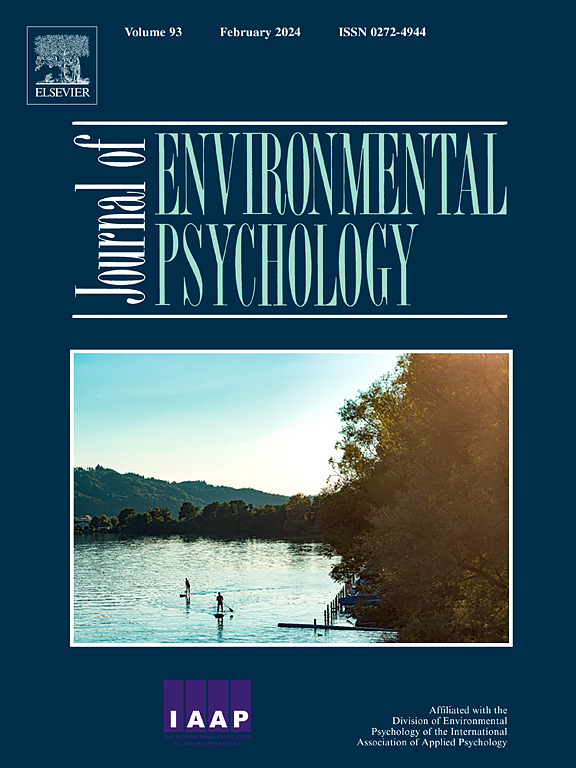识别与城市公园主观认知恢复和改善影响相关的品质和设施
IF 6.1
1区 心理学
Q1 ENVIRONMENTAL STUDIES
引用次数: 0
摘要
虽然参观公园通常被认为是一种“自然体验”,但并非所有的城市公园都是自然环境。此外,公园在提供便利设施和其他特征方面的支持方面也有所不同。在这项预先登记的横断面研究中,我们要求参与者(N = 303,芝加哥,美国居民)在两周的时间内参观几个城市公园(Nobs = 1234)。在参观期间,他们对自然、安全、维护和噪音进行了评分,并完成了感知恢复量表。他们还报告了他们的瞬间影响、主观认知恢复和对公园的偏好。使用理论驱动和数据驱动的方法,我们发现所有这些品质都与情感和认知结果有关。此外,我们发现,当参与者访问他们以前去过的公园时,他们报告想要在公园里做的活动和公园提供的设施之间的兼容性预测了偏好,但当参与者访问他们以前没有去过的公园时,这种关系不成立。总的来说,这项研究强调需要将环境心理学和休闲研究的方法结合起来,为城市绿化规划和政策提供更全面和全面的建议。本文章由计算机程序翻译,如有差异,请以英文原文为准。
Identifying qualities and amenities associated with subjective cognitive restoration and improved affect in urban parks
Although visiting a park is usually considered to be a ‘nature experience’, not all city parks are natural environments. Additionally, parks differ in the affordances they offer in terms of amenities and other characteristics. In this pre-registered, cross-sectional study we asked participants (N = 303, Chicago, USA residents) to visit several city parks over the course of two weeks (Nobs = 1234). While visiting, they rated naturalness, safety, maintenance, and noisiness, and completed the Perceived Restoration Scale. They also reported on their momentary affect, subjective cognitive restoration, and preference for the park. Using both theory-driven and data-driven approaches, we found that all these qualities were related to affective and cognitive outcomes. Additionally, we found that when participants visited a park they had been to before, compatibility between activities they reported wanting to do in the park and the amenities offered by the park predicted preference, but this relationship did not hold when participants visited a park they hadn't been to before. Overall, this study highlights the need to integrate approaches from both environmental psychology and leisure studies to generate more holistic and comprehensive recommendations for urban greening planning and policy.
求助全文
通过发布文献求助,成功后即可免费获取论文全文。
去求助
来源期刊

Journal of Environmental Psychology
Multiple-
CiteScore
10.60
自引率
8.70%
发文量
140
审稿时长
62 days
期刊介绍:
The Journal of Environmental Psychology is the premier journal in the field, serving individuals in a wide range of disciplines who have an interest in the scientific study of the transactions and interrelationships between people and their surroundings (including built, social, natural and virtual environments, the use and abuse of nature and natural resources, and sustainability-related behavior). The journal publishes internationally contributed empirical studies and reviews of research on these topics that advance new insights. As an important forum for the field, the journal publishes some of the most influential papers in the discipline that reflect the scientific development of environmental psychology. Contributions on theoretical, methodological, and practical aspects of all human-environment interactions are welcome, along with innovative or interdisciplinary approaches that have a psychological emphasis. Research areas include: •Psychological and behavioral aspects of people and nature •Cognitive mapping, spatial cognition and wayfinding •Ecological consequences of human actions •Theories of place, place attachment, and place identity •Environmental risks and hazards: perception, behavior, and management •Perception and evaluation of buildings and natural landscapes •Effects of physical and natural settings on human cognition and health •Theories of proenvironmental behavior, norms, attitudes, and personality •Psychology of sustainability and climate change •Psychological aspects of resource management and crises •Social use of space: crowding, privacy, territoriality, personal space •Design of, and experiences related to, the physical aspects of workplaces, schools, residences, public buildings and public space
 求助内容:
求助内容: 应助结果提醒方式:
应助结果提醒方式:


